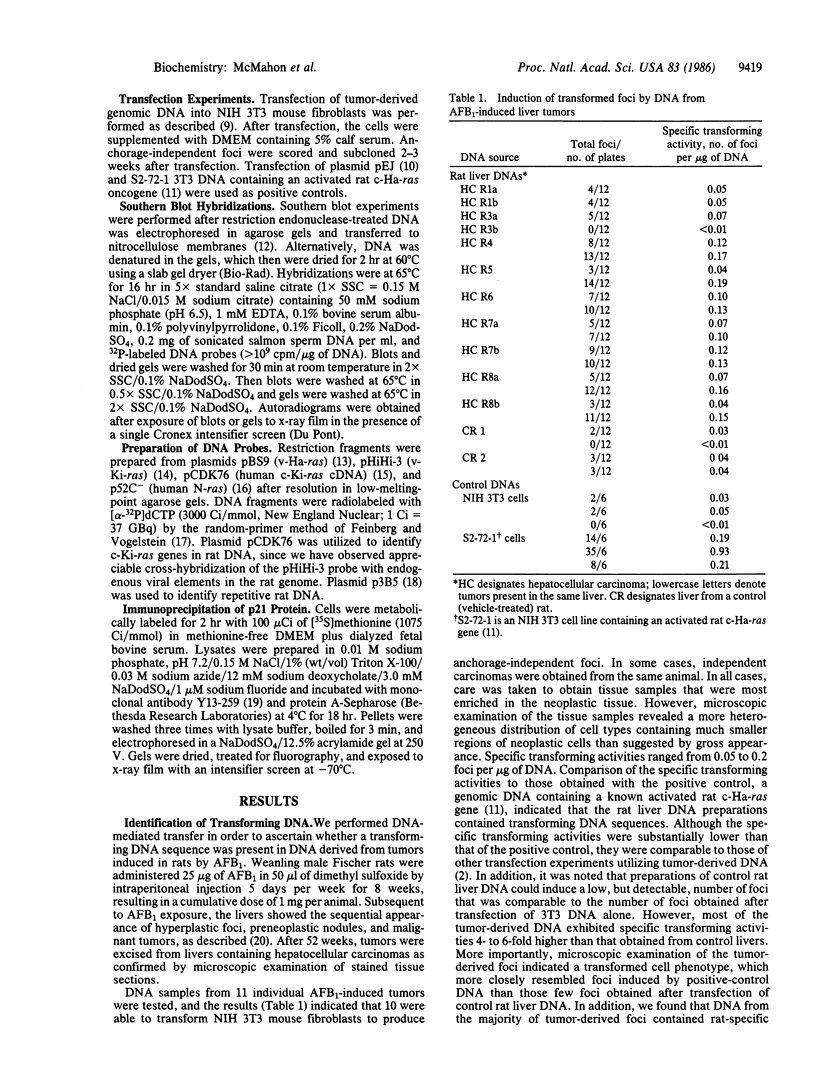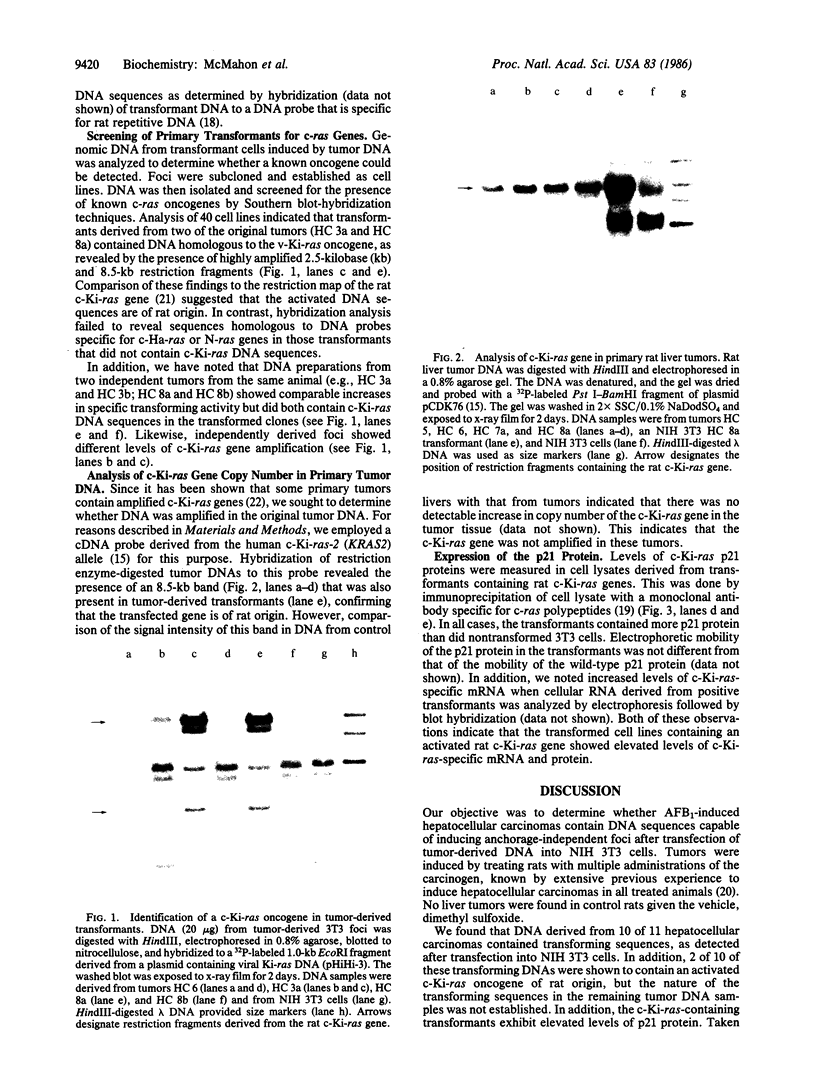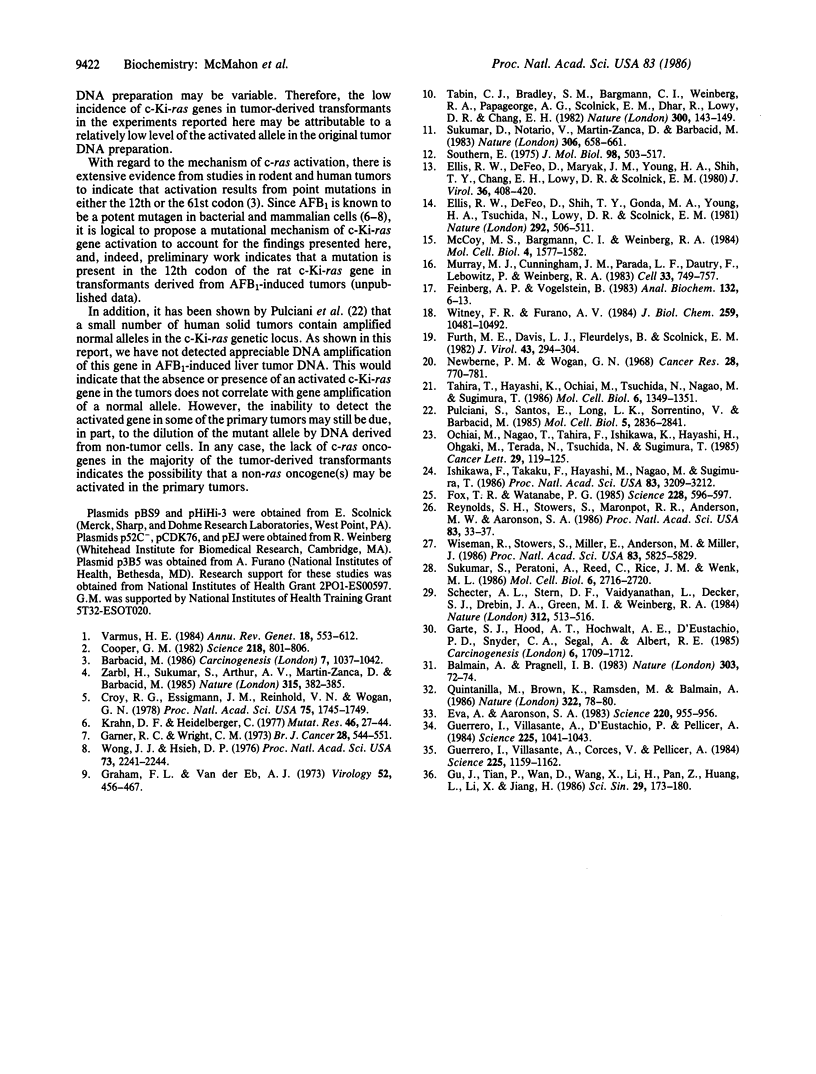Abstract
Weanling male Fischer rats were administered 40 intraperitoneal injections of aflatoxin B1 (25 micrograms per animal per day) over a 2-month period. This chronic dosing regimen resulted in the sequential formation of hyperplastic foci, preneoplastic nodules, and hepatocellular carcinomas in all of the animals treated. The presence of transforming DNA sequences was detected by formation of anchorage-independent foci after transfection of tumor-derived DNA in NIH 3T3 mouse fibroblasts. Transfection of genomic DNA isolated from individual tumors from eight animals resulted in specific transforming activities ranging from 0.05 to 0.2 foci per micrograms of DNA. Primary transfectant DNAs were analyzed by Southern blot hybridization with DNA probes homologous to c-Ha-ras, c-Ki-ras, and N-ras oncogenes. A highly amplified c-Ki-ras oncogene of rat origin was detected in transformants derived from tumors in two of the eight animals tested. There was no evidence to suggest the presence of c-Ha-ras or N-ras sequences in any of the transformants. Analysis of primary liver tumor DNA showed no Ki-ras DNA amplification when compared to control liver DNA samples. Increased levels of c-Ki-ras p21 proteins were detected in 3T3 transformants containing activated rat c-Ki-ras genes. The presence of c-Ki-ras sequences of rat origin capable of inducing transformed foci can be taken as evidence that the c-Ki-ras gene has been activated in the primary liver tumors.
Full text
PDF




Images in this article
Selected References
These references are in PubMed. This may not be the complete list of references from this article.
- Balmain A., Pragnell I. B. Mouse skin carcinomas induced in vivo by chemical carcinogens have a transforming Harvey-ras oncogene. Nature. 1983 May 5;303(5912):72–74. doi: 10.1038/303072a0. [DOI] [PubMed] [Google Scholar]
- Barbacid M. Oncogenes and human cancer: cause or consequence? Carcinogenesis. 1986 Jul;7(7):1037–1042. doi: 10.1093/carcin/7.7.1037. [DOI] [PubMed] [Google Scholar]
- Cooper G. M. Cellular transforming genes. Science. 1982 Aug 27;217(4562):801–806. doi: 10.1126/science.6285471. [DOI] [PubMed] [Google Scholar]
- Croy R. G., Essigmann J. M., Reinhold V. N., Wogan G. N. Identification of the principal aflatoxin B1-DNA adduct formed in vivo in rat liver. Proc Natl Acad Sci U S A. 1978 Apr;75(4):1745–1749. doi: 10.1073/pnas.75.4.1745. [DOI] [PMC free article] [PubMed] [Google Scholar]
- Ellis R. W., DeFeo D., Maryak J. M., Young H. A., Shih T. Y., Chang E. H., Lowy D. R., Scolnick E. M. Dual evolutionary origin for the rat genetic sequences of Harvey murine sarcoma virus. J Virol. 1980 Nov;36(2):408–420. doi: 10.1128/jvi.36.2.408-420.1980. [DOI] [PMC free article] [PubMed] [Google Scholar]
- Ellis R. W., Defeo D., Shih T. Y., Gonda M. A., Young H. A., Tsuchida N., Lowy D. R., Scolnick E. M. The p21 src genes of Harvey and Kirsten sarcoma viruses originate from divergent members of a family of normal vertebrate genes. Nature. 1981 Aug 6;292(5823):506–511. doi: 10.1038/292506a0. [DOI] [PubMed] [Google Scholar]
- Eva A., Aaronson S. A. Frequent activation of c-kis as a transforming gene in fibrosarcomas induced by methylcholanthrene. Science. 1983 May 27;220(4600):955–956. doi: 10.1126/science.6302839. [DOI] [PubMed] [Google Scholar]
- Feinberg A. P., Vogelstein B. A technique for radiolabeling DNA restriction endonuclease fragments to high specific activity. Anal Biochem. 1983 Jul 1;132(1):6–13. doi: 10.1016/0003-2697(83)90418-9. [DOI] [PubMed] [Google Scholar]
- Fox T. R., Watanabe P. G. Detection of a cellular oncogene in spontaneous liver tumors of B6C3F1 mice. Science. 1985 May 3;228(4699):596–597. doi: 10.1126/science.3983645. [DOI] [PubMed] [Google Scholar]
- Furth M. E., Davis L. J., Fleurdelys B., Scolnick E. M. Monoclonal antibodies to the p21 products of the transforming gene of Harvey murine sarcoma virus and of the cellular ras gene family. J Virol. 1982 Jul;43(1):294–304. doi: 10.1128/jvi.43.1.294-304.1982. [DOI] [PMC free article] [PubMed] [Google Scholar]
- Garner R. C., Wright C. M. Induction of mutations in DNA-repair deficient bacteria by a liver microsomal metabolite of aflatoxin B1. Br J Cancer. 1973 Dec;28(6):544–551. doi: 10.1038/bjc.1973.184. [DOI] [PMC free article] [PubMed] [Google Scholar]
- Garte S. J., Hood A. T., Hochwalt A. E., D'Eustachio P., Snyder C. A., Segal A., Albert R. E. Carcinogen specificity in the activation of transforming genes by direct-acting alkylating agents. Carcinogenesis. 1985 Dec;6(12):1709–1712. doi: 10.1093/carcin/6.12.1709. [DOI] [PubMed] [Google Scholar]
- Graham F. L., van der Eb A. J. A new technique for the assay of infectivity of human adenovirus 5 DNA. Virology. 1973 Apr;52(2):456–467. doi: 10.1016/0042-6822(73)90341-3. [DOI] [PubMed] [Google Scholar]
- Gu J. R., Tian P. K., Wan D. F., Wang X., Li H. N., Pan Z. M., Huang L. H., Li X. Z., Jiang H. Q. Identification of human N-ras as the common oncogene in NIH 3T3 cells transformed with DNAs from human primary hepatic cancer and hepatoma 7402 line. Sci Sin B. 1986 Feb;29(2):173–180. [PubMed] [Google Scholar]
- Guerrero I., Villasante A., Corces V., Pellicer A. Activation of a c-K-ras oncogene by somatic mutation in mouse lymphomas induced by gamma radiation. Science. 1984 Sep 14;225(4667):1159–1162. doi: 10.1126/science.6474169. [DOI] [PubMed] [Google Scholar]
- Guerrero I., Villasante A., D'Eustachio P., Pellicer A. Isolation, characterization, and chromosome assignment of mouse N-ras gene from carcinogen-induced thymic lymphoma. Science. 1984 Sep 7;225(4666):1041–1043. doi: 10.1126/science.6089339. [DOI] [PubMed] [Google Scholar]
- Ishikawa F., Takaku F., Hayashi K., Nagao M., Sugimura T. Activation of rat c-raf during transfection of hepatocellular carcinoma DNA. Proc Natl Acad Sci U S A. 1986 May;83(10):3209–3212. doi: 10.1073/pnas.83.10.3209. [DOI] [PMC free article] [PubMed] [Google Scholar]
- Krahn D. F., Heidelberger C. Liver homogenate-mediated mutagenesis in chinese hamster V79 cells by polycyclic aromatic hydrocarbons and aflatoxins. Mutat Res. 1977 Feb 1;46(1):27–44. doi: 10.1016/0165-1161(77)90108-x. [DOI] [PubMed] [Google Scholar]
- McCoy M. S., Bargmann C. I., Weinberg R. A. Human colon carcinoma Ki-ras2 oncogene and its corresponding proto-oncogene. Mol Cell Biol. 1984 Aug;4(8):1577–1582. doi: 10.1128/mcb.4.8.1577. [DOI] [PMC free article] [PubMed] [Google Scholar]
- Murray M. J., Cunningham J. M., Parada L. F., Dautry F., Lebowitz P., Weinberg R. A. The HL-60 transforming sequence: a ras oncogene coexisting with altered myc genes in hematopoietic tumors. Cell. 1983 Jul;33(3):749–757. doi: 10.1016/0092-8674(83)90017-x. [DOI] [PubMed] [Google Scholar]
- Newberne P. M., Wogan G. N. Sequential morphologic changes in aflatoxin B carcinogenesis in the rat. Cancer Res. 1968 Apr;28(4):770–781. [PubMed] [Google Scholar]
- Ochiai M., Nagao M., Tahira T., Ishikawa F., Hayashi K., Ohgaki H., Terada M., Tsuchida N., Sugimura T. Activation of K-ras and oncogenes other than ras family in rat fibrosarcomas induced by 1,8-dinitropyrene. Cancer Lett. 1985 Nov;29(2):119–125. doi: 10.1016/0304-3835(85)90150-8. [DOI] [PubMed] [Google Scholar]
- Pulciani S., Santos E., Long L. K., Sorrentino V., Barbacid M. ras gene Amplification and malignant transformation. Mol Cell Biol. 1985 Oct;5(10):2836–2841. doi: 10.1128/mcb.5.10.2836. [DOI] [PMC free article] [PubMed] [Google Scholar]
- Quintanilla M., Brown K., Ramsden M., Balmain A. Carcinogen-specific mutation and amplification of Ha-ras during mouse skin carcinogenesis. Nature. 1986 Jul 3;322(6074):78–80. doi: 10.1038/322078a0. [DOI] [PubMed] [Google Scholar]
- Reynolds S. H., Stowers S. J., Maronpot R. R., Anderson M. W., Aaronson S. A. Detection and identification of activated oncogenes in spontaneously occurring benign and malignant hepatocellular tumors of the B6C3F1 mouse. Proc Natl Acad Sci U S A. 1986 Jan;83(1):33–37. doi: 10.1073/pnas.83.1.33. [DOI] [PMC free article] [PubMed] [Google Scholar]
- Schechter A. L., Stern D. F., Vaidyanathan L., Decker S. J., Drebin J. A., Greene M. I., Weinberg R. A. The neu oncogene: an erb-B-related gene encoding a 185,000-Mr tumour antigen. Nature. 1984 Dec 6;312(5994):513–516. doi: 10.1038/312513a0. [DOI] [PubMed] [Google Scholar]
- Southern E. M. Detection of specific sequences among DNA fragments separated by gel electrophoresis. J Mol Biol. 1975 Nov 5;98(3):503–517. doi: 10.1016/s0022-2836(75)80083-0. [DOI] [PubMed] [Google Scholar]
- Sukumar S., Notario V., Martin-Zanca D., Barbacid M. Induction of mammary carcinomas in rats by nitroso-methylurea involves malignant activation of H-ras-1 locus by single point mutations. Nature. 1983 Dec 15;306(5944):658–661. doi: 10.1038/306658a0. [DOI] [PubMed] [Google Scholar]
- Sukumar S., Perantoni A., Reed C., Rice J. M., Wenk M. L. Activated K-ras and N-ras oncogenes in primary renal mesenchymal tumors induced in F344 rats by methyl(methoxymethyl)nitrosamine. Mol Cell Biol. 1986 Jul;6(7):2716–2720. doi: 10.1128/mcb.6.7.2716. [DOI] [PMC free article] [PubMed] [Google Scholar]
- Tabin C. J., Bradley S. M., Bargmann C. I., Weinberg R. A., Papageorge A. G., Scolnick E. M., Dhar R., Lowy D. R., Chang E. H. Mechanism of activation of a human oncogene. Nature. 1982 Nov 11;300(5888):143–149. doi: 10.1038/300143a0. [DOI] [PubMed] [Google Scholar]
- Tahira T., Hayashi K., Ochiai M., Tsuchida N., Nagao M., Sugimura T. Structure of the c-Ki-ras gene in a rat fibrosarcoma induced by 1,8-dinitropyrene. Mol Cell Biol. 1986 Apr;6(4):1349–1351. doi: 10.1128/mcb.6.4.1349. [DOI] [PMC free article] [PubMed] [Google Scholar]
- Varmus H. E. The molecular genetics of cellular oncogenes. Annu Rev Genet. 1984;18:553–612. doi: 10.1146/annurev.ge.18.120184.003005. [DOI] [PubMed] [Google Scholar]
- Wiseman R. W., Stowers S. J., Miller E. C., Anderson M. W., Miller J. A. Activating mutations of the c-Ha-ras protooncogene in chemically induced hepatomas of the male B6C3 F1 mouse. Proc Natl Acad Sci U S A. 1986 Aug;83(16):5825–5829. doi: 10.1073/pnas.83.16.5825. [DOI] [PMC free article] [PubMed] [Google Scholar]
- Witney F. R., Furano A. V. Highly repeated DNA families in the rat. J Biol Chem. 1984 Aug 25;259(16):10481–10492. [PubMed] [Google Scholar]
- Wong J. J., Hsieh D. P. Mutagenicity of aflatoxins related to their metabolism and carcinogenic potential. Proc Natl Acad Sci U S A. 1976 Jul;73(7):2241–2244. doi: 10.1073/pnas.73.7.2241. [DOI] [PMC free article] [PubMed] [Google Scholar]
- Zarbl H., Sukumar S., Arthur A. V., Martin-Zanca D., Barbacid M. Direct mutagenesis of Ha-ras-1 oncogenes by N-nitroso-N-methylurea during initiation of mammary carcinogenesis in rats. 1985 May 30-Jun 5Nature. 315(6018):382–385. doi: 10.1038/315382a0. [DOI] [PubMed] [Google Scholar]





